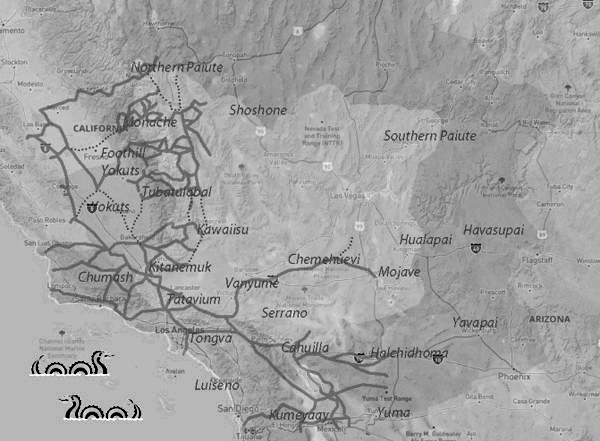Native Americans

California Indian Trade Trails
This story of the origins of the southern route is seriously incomplete without consideration of the role played by Native Americans in the discovery and pathfinding. Historians long ago stopped writing that Spanish, Mexican or American explorers were "first to see..." or "first to cross...," thereby acknowledging that a great number of Indians had seen first and crossed first. But because of the absence of written records, Indians have received little or no credit for feats of exploration or discovery.
Most white explorers in what is now the United States Southwest were not pathfinders. Ample evidence indicates that Indians traded rather extensively between New Mexico, the interior of Mexico, and California long before the appearance of Europeans in Mexico. Spaniards, Mexicans, and Americans who ventured into these lands almost always found local Indians who were willing to point out trails that they knew and traveled often.
Most white explorers in the Southwest depended upon Indian guides. When they did not, their diaries show that they often got lost. Garces, for example, one of the ablest of explorers, was a master at finding guides who would escort him through their own lands. On at least one occasion, when his native guides refused to go in a direction in which he insisted, Garces relented and followed them along a path they knew. On two other occasions, when he refused to follow the advice of his guides, he got lost. Even mountain men sometimes found it expedient to employ Indian guides.
While the stories of attacks by Apaches on travelers in 1849 and after are well known, the literature of the Southwest also is full of evidence of friendly contacts between whites and Indians. From Kino through Cooke, the Pimas in their villages along the Gila River welcomed white explorers. Garces and his Mojave companions of the trail grieved at their last parting. Kino, Garces, and Anza alike were impressed with the eagerness of the Yumas to associate with the Spanish. Surely no other people in history have ever sought so earnestly to adopt an alien culture as the Yumas sought to place themselves under the sovereignty of the Spanish crown and Church. The Yumas were not the only Indian people so inclined. Most tribes in the Pimeria Alta sought to enter the Spanish fold in some fashion. Even the Apaches, scourge of the Spaniards and Mexicans, were largely friendly to Americans in earliest contacts. Mountain men found that Apaches hated and preyed upon Mexicans but had respect, if not admiration, for Americans. Kearny and Cooke also benefited from this sentiment. They employed Apache guides and traded with them for mules and provisions. Cordiality vanished, however, when the United States declared its sovereignty over Apacheria and tried to manage the Apaches of Arizona and New Mexico.
Previous - Next